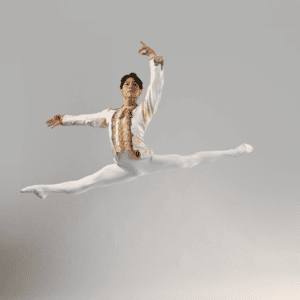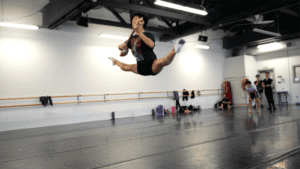
In his first season with Sacramento Ballet, Seungkyun Park brings a unique blend of classical and contemporary artistry shaped by his training in South Korea and his diverse performance experiences. From starting his ballet journey at 17 to earning a bronze medal at the Valentina Kozlova International Ballet Competition, Seungkyun’s path has been anything but traditional. In this interview, he shares insights into his journey, his challenges, and his excitement around moving to Sacramento.
- Starting ballet at age 17 is quite rare in the dance world. What inspired you to begin dancing at that time, and how did you manage to progress so quickly?
When I was a kid, I danced urban hip-hop with my friends. Eventually, I started asking professionals for advice on how to better my hip-hop technique. They recommended that I start taking ballet and modern classes to learn fundamentals. Immediately, I was drawn to the precision of ballet technique and knew I wanted to pursue a professional career. I worked relentlessly, averaging 14-16 hours of training per day to make up for my late start as a 17-year-old.
- How did your experiences at Deokwon Arts High School and Korea National University of Arts shape your approach to ballet, and how did the combination of classical, contemporary, and traditional Korean dance influence your style?
Surprisingly, it was easy to adapt to the teachings of the schools I trained with, since I had no prior experience in traditional ballet. Using the combination of all three styles, I learned to strengthen my understanding of technique and artistry.
- Coming from South Korea, how has your cultural background influenced your perspective as a dancer? Do you find yourself drawing on traditional Korean dance in your performances?
My cultural background has enlightened my perspective in various ways. Korean traditional dance uses lots of port de bras and arm work, so utilizing the corrections and training, I create the most flattering lines for my body.
- After pausing your career for mandatory military service, how did you mentally and physically prepare to return to dance? What challenges did you face during that transition?
My transition from the military back to ballet was difficult yet rewarding. While I stayed physically fit in the military, I was not able to use and maintain the specific muscles and flexibility needed for ballet. Mentally, the transition taught me that anything is possible, if I dedicate myself and my mind to it.
- You’ve performed in several of George Balanchine’s iconic works. How has dancing Balanchine’s choreography shaped your artistry, and what do you enjoy most about his style?
Performing in George Balanchine’s works is an invaluable experience and milestone in my career. My favorite thing about his specific style is the synchronization of musicality and choreography, as demonstrated in his “Theme and Variations”, which is one of my favorite ballets to perform.

- You’ve danced a variety of roles, from classical ballets like Swan Lake to modern works like The Rite of Spring. How do you prepare for such diverse performances, and which type of role do you find most fulfilling?
Switching your perspective in a diverse repertoire is the most challenging part. In ballet, it is simple to differentiate between correct and incorrect technique. In modern, there is no “right” or *wrong” technique. For me, I find classical roles the most fulfilling to perform.
- As you begin this new chapter with Sacramento Ballet, what are your goals for the future? Are there specific roles or ballets you’re particularly excited to take on?
I was very excited for Romeo & Juliet this season. While I have performed excerpts from Romeo & Juliet, I l=really enjoyed experiencing the choreographic process that a world premiere entails.
- How do you approach creating a deep connection with the audience, especially when performing in emotionally demanding pieces?
I strive to portray the intention of a choreographer. Embracing strong emotions that match the concept of a piece is the best way to connect with the audience.
- Having performed with companies like Columbia Classical Ballet and Texas Ballet Theater, how do you think those experiences have prepared you for your debut with Sacramento Ballet?
My training focused on technique and precision. Dancing with professional companies helped me realize the importance of artistry and acting ability. I am optimistic that the repertoire for this season at Sacramento Ballet will harbor growth in all aspects of my professional career.
